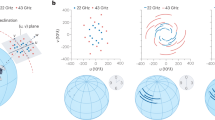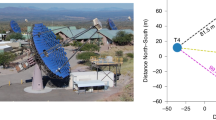Abstract
THE construction of a telescope of very large aperture is necessarily an experiment the final success of which can be determined only by the results of astronomical observations. After the mechanical and optical difficulties have been overcome, there remain those disturbances of the atmosphere which are of little importance with small apertures and low magnifying powers, but become more and more serious as the diameter of the objective and the scale of the image are multiplied. Thus in undertaking the construction of a reflecting telescope of 100-in. aperture, while we had the advantage of experience with the 60-in. Mount Wilson reflector, we frankly recognised that the outcome must remain in question until the completion of tests made under customary atmospheric conditions.
This is a preview of subscription content, access via your institution
Access options
Subscribe to this journal
Receive 51 print issues and online access
$199.00 per year
only $3.90 per issue
Buy this article
- Purchase on Springer Link
- Instant access to full article PDF
Prices may be subject to local taxes which are calculated during checkout
Similar content being viewed by others
References
In pactice, a somewhat different technique, giving the same result with higher precision, is employed by Dr. Anderson.
For an account of this method, see Michelson, "On the Application of Interference Methods to Astronomical Measurements," Phil. Mag., July 1890.
Author information
Authors and Affiliations
Rights and permissions
About this article
Cite this article
HALE, G. Some Test of the 100-in. Hooker Telescope. Nature 105, 266–268 (1920). https://doi.org/10.1038/105266a0
Issue Date:
DOI: https://doi.org/10.1038/105266a0
Comments
By submitting a comment you agree to abide by our Terms and Community Guidelines. If you find something abusive or that does not comply with our terms or guidelines please flag it as inappropriate.



